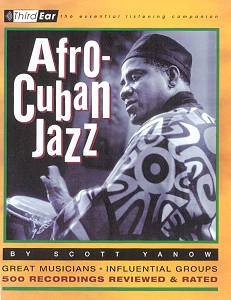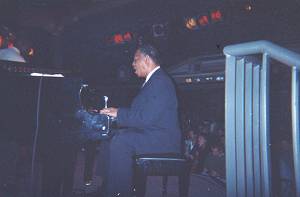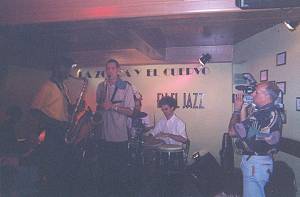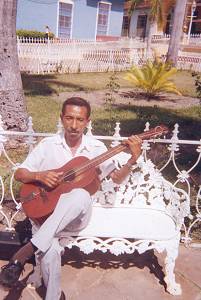HAVANA, CUBA--Friends had told me to expect music everywhere I went in Havana: in the bars and clubs, coming out of doorways, windows and taxis, an outpouring of Latin polyrhythms that went on all day and night, like a soundtrack. What I hadn't expected to find, though, was a vast amount of jazz played by musicians of the highest calibre, both oldtimers and youngsters alike.
I would have been better prepared had I brought along Scott Yanow's recently released AFRO-CUBAN JAZZ, a book which contains a brief history of the music and a biographical guide to the men and women who made it famous. Yanow describes how the music evolved, combining elements of Nigerian slave drum beats, Spanish songs and language and remnants of Indian chants. It was in Cuba that the
clave was developed. As Yanow says, "The clave is the basis for all Cuban music, an offbeat rhythmic pattern over two bars, made originally by the clashing together of two little wooden sticks.

"The influence of Cuban music was first heard in the music of Louisiana's
composer and piano virtuoso Louis Moreau Gottschalk, who visited Cuba
in 1854 and wrote several works that used Cuban rhythms," Yanow continues.
"An early rhythm, the habanera was a descendant of the contradanza
(a Spanish line dance), adding syncopation and soon influencing (and overlapping
with) the Argentine tango. In the mid-1860s, Sebastian Yradier's 'La Paloma'
(which uses the habanera) became the first major Latin hit in the United
States through its sheet music sales."
The road to contemporary
Afro Cuban jazz runs through artists such as Scott Joplin, Jelly Roll
Morton, Perez Prado and Machito, who in 1947 influenced such American
jazz giants as Stan Kenton and Dizzy Gillespie. Other Cuban jazz musicians
such as Chico O'Farill, Cal Tjader, Mongo Santamaria, Willie Bobo, Arturo
Sandoval and Chucho Valdez emerged to carry the music to new heights.

Today the jazz scene in Havana is spearheaded by two state-owned clubs,
the Jazz Cafe and La Zorra y El Cuevo (The Fox & The Crow). Of equal
importance are the Havana Jazz International Festival (held annually every
year since 1980) and Caliente! (a smaller, more local-oriented but equally
swinging get-together). A Swiss company, Sound Managers, co-produces the
latter festival with the Cuban Musical Institute.
Last year the week-long
International Festival featured the likes of Dee Dee Bridgewater, Chucho
Valdez, Chano Dominguez (Spain) and Herbie Hancock (USA). Some dynamite
female bands were also headlined, such as Clarissa y Las Diablitas and
a group from Germany. This year's four-day Caliente! festival offered
the live salsa group Juan Formell y Los Van Van, and an all-star jazz
band led by Valdez, plus hot dj's and Tropicana dance troupes.

The Jazz Cafe is located in Havana's first shopping mall, up on a third
floor overlooking the malecon (waterfront). The first part of the evening
is given over to food, drink and recorded music (not necessarily jazz).
Open for two years, the club offers a live band every night, kicking off
at about 11 PM. Most of the bands are local, with names like Diakara and
Top Secret (which won the national music contest last year). Occasionally
groups from abroad play here, such as the Canadian band Wishworld.
The hottest jazz club in Havana is, without doubt, The Fox & The Crow. Its manager, Tony Orlando, is Cuban-born but has spent considerable time abroad, dealing with the agents and managers who supply the International Festival with talent. Orlando also writes about jazz in Cuban periodicals, hosts a Sunday night jazz show on Radio Cadena Habana and introduces the bands at The Fox & The Crow (in both Spanish and English). The man is a human dynamo.
There is a five-dollar
cover charge at the club, but food and drink are reasonable--and the music
fantastic. On the first of my three nights there I heard a band led by
a young pianist, Roberto Fonseca, who blew me away with his fire, virtuosity
and drive. (Fonseca's band is called "Temperamento"). Just as
remarkable was a 17-year-old alto sax player, Roberto Martinez, who jammed
with Fonseca. Both of these up-and-coming stars were trained at either
the Fine Arts Institute or the Cuban Music Institute and are proud children
of the revolution.
The next night I heard a different band, this one playing a horn-led fusion
of Madagascaran, Cuban and jazz styles that was so infectious and captivating
that half the audience got up and danced.
Ortega also told
me about a whole slew of other outstanding jazz musicians who can be heard
in Havana today: Elmer Ferrer, Yasek Manzano, Jesus Fuentes, Toni Perez,
Alexis Bosch, Mario Hernadez, Toni Rodriguez, Jonge Chicay, to name just
a few. So high is the level of musicianship, he said, that many European
companies come to Havana to record their latest CDs, whether the music
is Latin-flavored or not.
orlando@cubarte.cult.cu

